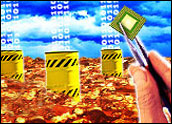
There’s probably no field of applied scientific research with applications as diverse and implications as profound as nanotechnology. Advances are coming fast and the research environment is heady as billions of dollars each year go into nanotech research and development.
“When the nanotech wave comes to shore, it will bring rapid, monumental, inescapable and potentially devastating change. Nanotechnology is a ‘platform technology,’ meaning that it has the potential to alter or completely transform the current state of the art in every major industrial sector, not just one — medicine, food and agriculture, electronics and computing, materials and manufacturing. In the coming years, technologies converging at the nanoscale will revolutionize the design and manufacture of new materials across all industrial sectors,” the ETC Group’s Kathy Jo Wetter, Ph.D., told TechNewsWorld.
Yet while nanotechnology’s potential benefits are widely acknowledged, opinions differ considerably when it comes to the potential threats to human and environmental health. Even as growing numbers of nanomaterials make their way into a greater range of products, scientists and public interest groups decry the lack of research standards and government oversight. Industry participants and government agencies, on the other hand, claim they are up to the challenge and are committed to ensuring the health and safety of the public and the environment.
Nanotech Health and Safety Alert
The diversity of potential uses of nanoengineered materials and nanotech’s profoundly disruptive ramifications for the global industrial and economic order are truly amazing. Spy agencies are reportedly looking into using nanoparticle paints that function as video surveillance cameras. Rumored potential military applications include explosives that are triggered only if nanomaterials verify a target’s DNA.
As far out and far off as these may be, nanomaterials are already included a range of consumer products — including skin cream and suntan lotion — and it’s these that have scientists and public interest groups on red alert.
“Any product that directly exposes consumers to nanoparticles is our greatest concern,” explained Friends of the Earth spokesperson Ian Illuminato. “Nanoparticles that are applied to the skin, eaten and or breathed — such as with foods and cosmetics — are extremely risky, because once they enter our bodies, studies have shown that they can pretty much access and penetrate any part of our bodies, including the blood-brain barrier.”
While nanotechnology products — such as solar energy and electric vehicle components — hold great promise, the risks they pose to human and environmental health and safety have not been fully assessed, Illuminato told TechNewsWorld. “Life cycle risk assessments need to be made in order to protect workers and the environment before we allow these products to be commercialized.”
The Cart and the Horse
Government oversight of nanomaterials is practically nonexistent. The UK Royal Society and the Academy of Engineering have warned governments that nanoparticles should be treated as new chemicals and should be subject to rigorous safety testing prior to commercial release, Illuminato noted.
“However, to date, nano manufacturers in the United States are still not required to identify nanoparticle ingredients on product labels or to conduct new nanospecific safety tests on these ingredients. No government has yet established regulation to protect consumers from nanotechnology’s risks or even allow the public to make informed choices through proper labeling. Until governments act, consumers should be wary and should inform themselves as best as they can.”
“In a nutshell,” Wetter explained, “substances produced at the nanoscale can behave as if they were altogether different substances from their familiar, larger-scale counterparts. Their novel properties are precisely why there is so much scientific and commercial interest in nanoscale materials.
“There is a virtual consensus among scientists that the toxicology of engineered nanomaterials is largely unknown, and that toxicity data cannot be extrapolated from existing toxicology studies conducted on larger-scale materials. In short, we don’t know what accumulated amounts of any human-made nanomaterial will do in our lungs or our livers or our guts, even if we do know how bigger particles of the same material behave in our bodies. The closest thing we have to go on is our experience with similarly-sized ultrafine particulate matter in air pollution, and no toxicologist in the world is arguing for the benign nature of air pollution.”
Call for Regulation
The ETC (Erosion, Technology and Concentration) Group has been monitoring the development of nanoscale technologies since 2000. Since 2002, it has gone so far as to urge the U.S. government to impose a moratorium on the introduction of products with new, insufficiently tested nanoengineered particles.
“Though we focus on the socioeconomic impacts of technologies, in the case of nanotech, we couldn’t ignore the potential health and safety impacts,” Wetter recounted. “Seven years ago, we were stunned to realize that there were no internationally accepted scientific standards governing lab research or the introduction of nanomaterials in commercial products.”
“There were virtually no toxicology studies devoted to synthetic nanomaterials. There were no standards for describing or even measuring nanoscale materials. There were no labeling requirements. In short, there was a regulatory vacuum. And that regulatory vacuum persists today, despite the fact that hundreds of products containing engineered nanomaterials have been commercialized,” she added.
The limited amount of peer-reviewed scientific studies on the effects of nanomaterials on the public, workers and ecosystems means that commercial, industrial and government decision makers do not have a full understanding of the potential threats to human and environmental health, Friends of the Earth’s Illuminato said. “Moreover, there is scientific evidence that indicates that certain nanomaterials are potentially harmful and risky.”
Carbon Nanotubes
Carbon nanotubes, or CNTs, is one category of the first generation of nanoparticles, one that has “novel and extraordinary electrical, thermal and mechanical properties,” explained Art Swift, president and CEO of Unidym, a leading player in their design, manufacture and application. The company provides bulk materials and CNT-enabled products and intellectual property to a wide range of customers and business partners, though it is focused on the electronics industry, where initial products include transparent electrodes for touch screens, flat panel displays, solar cells, and solid state lighting; electrodes for fuel cells; and thin film transistors for printable electronics.
As a pioneer in the field, Unidym takes its environmental, health and safety responsibilities very seriously, Swift told TechNewsWorld. Unidym is a founding member of multi-stakeholder ICON (the International Council on Nanotechnology), as well as ASTM International — the international arm of the American Society for Testing and Materials — its E56 Nanotechnology Committee and E56.03 Subcommittee for Environmental Health & Safety. “This subcommittee has been working on a set of safety standards for the handling of engineered nanoscale particles in industrial settings,” Swift elaborated.
Unidym is also a corporate member of the American National Standards Institute and participated in its Nanotechnology Steering Panel, which contributed to the development of a national standards strategy as part of the federal government’s National Nanotechnology Initiative.
In addition, “we are supporting the DuPont/Environmental Defense Nano Risk framework which provides tools for evaluating and addressing the potential challenges of nanoscale materials,” Swift continued, and “we are actively involved in, and/or sponsoring, a variety of promising research on the application of carbon nanotubes in the fields of medical devices, anti-cancer drug delivery, and several other life sciences applications.”





















































